I love the spring and summer, that’s the time I can indulge in close up flowers photography.
I enjoy watching roses and other flowers grow and bloom. Their brilliant colors and nature’s details excite me. And if it’s not outside, it is at times like these that I will also treat myself to a big, beautiful bouquet and go to work taking pictures in my kitchen – sometimes you have to be creative.
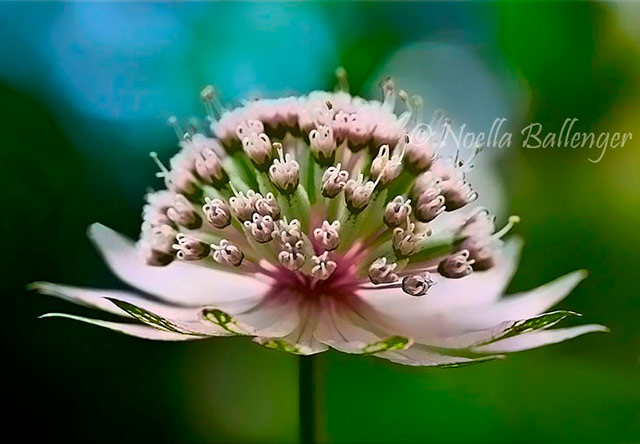
I’m lucky enough to have a kitchen that’s flooded with plenty of light during the morning hours, so I can place a small table near the sliding glass door, and it’s almost as good as being outside. I often bring a ladder in from the garage.
One of my favorite images of the tulips below was taken on a ladder using pink wrapping paper out-of-focus in the background and reflected light from the white refrigerator as fill light. It was great fun, and it resulted in a really successful image.
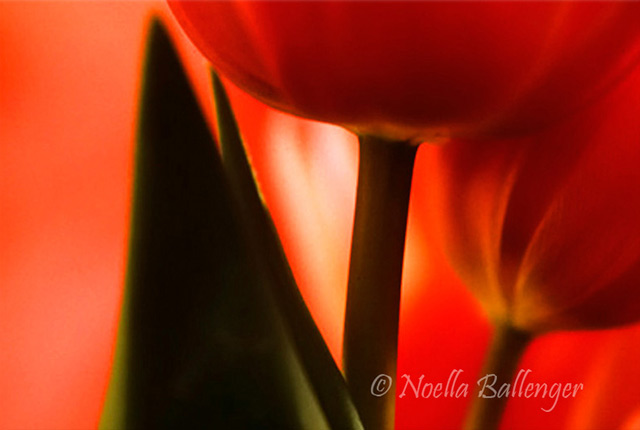
When I set up in my kitchen, I use a tripod, turn off any lights, and allow natural light and reflectors to become the light source.
Getting “intimate” with the blossoms may be as simple as focusing on the edge of a petal or the center of a blossom and eliminating all of the surrounding area. You can also photograph surrounding flowers or entire bouquet and still achieve the same close feeling.
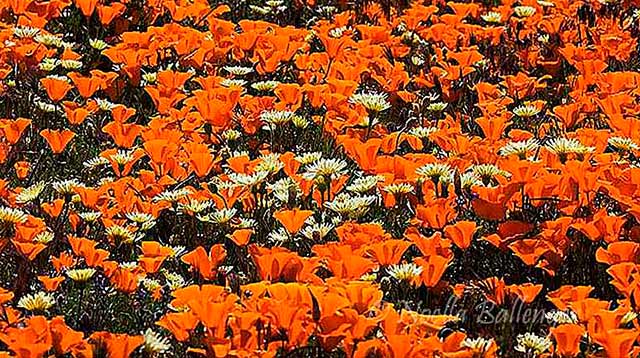
Poppy Field
Let’s talk about practical ways to see and feel the joy of close up flowers photography. Feeling is what this sort of photography is all about.
You’re interpreting what you feel and think about the subject. One of the reasons I love roses and have so many is that they smell delicious. In my yard, I have a saying, “If they don’t have a sent, they don’t stay!” For me, the intimacy of the flower is tied up in its beautiful aroma.
When I try to photograph flowers, I want to share those feelings with the viewers. I ask them to come close and catch the delicate fragrance. Each petal that is so soft and velvety beckons to the viewer to come and partake of its essence.
When we think of flower photography, we often think of macro lenses. But, in practical terms, not everyone can afford a macro lens. So, let’s work with the lenses we have and try to pull intimacy into the image.
Remember, it isn’t always necessary to have the “perfect” lens or to move so close that you can count the fuzzy hairs or bumps on a leaf. Think about your goal, your vision, and use what you have to express your feelings. For example, my all-time favorite lens for flower photography is a 100-300mm zoom lens. I sometimes add a couple of attachments like a tube and/or tele-extender.
Admittedly, I love my macro lens, as well, but I can do wonderfully intimate portraits with either one. So, if the right lens or equipment is holding you back, let me show you techniques and some less expensive equipment that you may want to acquire to work around those limitations.
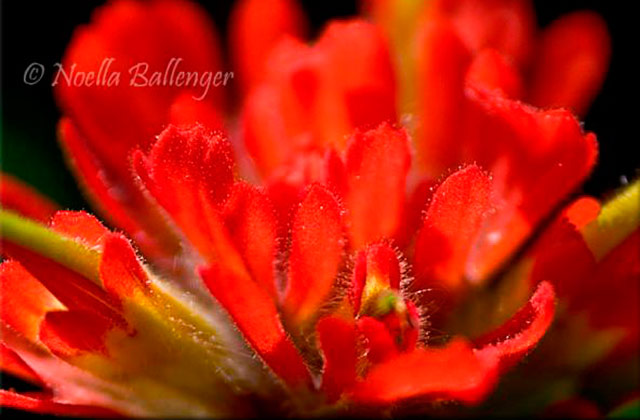
Fuzzy Edges on Indian Paintbrush
First, when I talk about “macro” photography, I’m talking about a non-scientific requirement. If we needed to measure a size relationship exactly, we would need the proper equipment to do a proper job. But when we talk about feelings and intimacy, we can use almost any lens to make the viewer see what we want them to see.
Consider my 100-300mm zoom lens, as an example. It has a specific minimum distance at which it will focus. Select a telephoto lens and find the closest focus spot with that lens. Take out a tape measure and measure the distance.
That is the distance you need to stand away from the object you’re photographing to have it appear in focus. I like to use telephoto lenses, because the nature of a telephoto lens limits the depth-of-field to a very narrow focal band front to back and compresses distances.
One of the ways to create intimacy and control the viewer is to make the focal point very selective and allow the depth-of-field to be very shallow. Your viewer’s eye will go to the spot that’s in focus. No matter how hard you try to move away from the point of focus, if you have limited the depth of field, the viewer will always return to that point.
Examine the image called “Yellow Flower Center.” There’s only one spot that’s in focus, and your eye returns to that exact location repeatedly. And don’t forget to use contrasting light to draw attention to a particular area within an image.
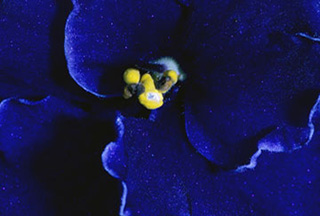
Contrast in color also pulls the viewer’s eye to the in-focus spot.
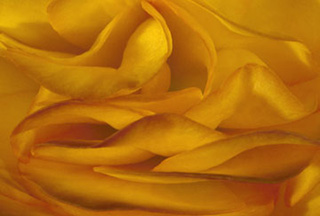
A variation in contrasting light will also draw the viewer to an area that is in focus.
Equipment Suggestions For Close Up Flowers Photography
Here are equipment suggestions to help you achieve a macro feeling and intimacy in your images. Other equipment is not always necessary, but it can be helpful in getting closer to your subject. (As with all of my equipment, I try to get the “best” glass I can afford.)
Using a combination of a long lens, tele-converter, and tubes, you can get inside of the flower. A macro lens with these combinations allows you in, as well. Experiment and see what the flower looks like really close. Light loss was significant, but I was using a tripod, so I could handle the longer exposure time.
1. A tube: This is a simple spacer (no glass in it) that goes between your camera and lens. It lets you create a larger image. The drawback is you lose light, because the light has a greater distance to travel to the sensor. Tubes usually cost somewhere between $50 – $100.
2. Teleconverters (1.4x or 2x): These lenses are most frequently used as “binoculars,” allowing a 100 mm lens to become a 200mm with a 2x teleconverter. Again, you’ve moved the lens away from the camera, so there is a loss of light. Tele-converters can cost up to several hundred dollars.
3. Close-up or Macro Lens Filter: The effect of these is like putting a small magnifying filter on the front of your lens. There’s no loss of light, because it doesn’t come between the camera and the lens. They come in different strengths. You can find excellent ones for about $40.00 each. They are my least favorite equipment to use, but they can get the job done.
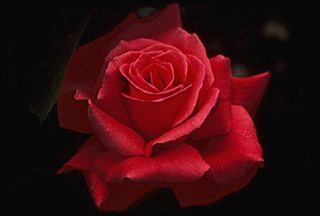
One pride-and-joy from my own garden is my roses. This one is called Pink Perfection, and it’s a delight. The petals are velvety smooth and the fragrance is warm and rich.
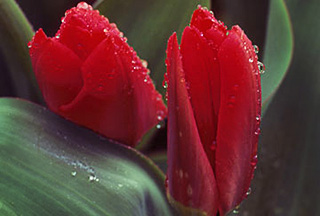
These tulips were made during a pause in a rain shower at the Skagit Valley Tulip Festival in Washington. They were droopy and wet but vivid in color.
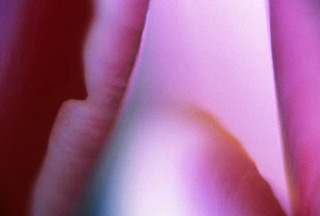
Just for fun, I switched from daylight to tungsten and played with the tulips. Again, I think I had every piece of equipment that I could screw together attached to the camera. And, yes, struggling to get the tripod exactly where I wanted it to be was a challenge. I wanted to show a fantasy world that an insect might see – waves of color and light.
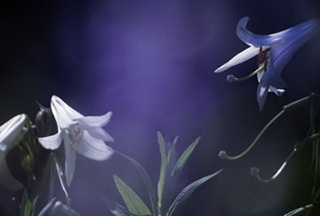
Intimate flower images don’t necessarily have to be close-ups. Notice the soft purple haze over the image. The haze is made by using a long lens (300 mm) and minimum depth-of-field (f4), and holding something (an iris flower petal) directly in front of the lens. Because the petal is in front of the point-of-focus in the image, it is totally out of focus and creates a nice color haze.
A special note here on equipment: Even though manufacturers don’t recommend using any of these items in combination with the others, sometimes–just for fun–I put them all on. It’s a wild combination, but you can achieve great and fun results that probably aren’t what you expected.
Here are some other tips to make your flower experience successful:
1. With depth-of-field at a minimum in close-up photography, attempt to keep the film plane parallel to the subject. This technique will give you a greater opportunity to have the entire subject appear to be in focus. Also, it gets you down to the same level as the flower, a much friendlier angle from which to photograph.
2. Using through-the-lens metering keeps complications at a minimum. (That is one of the reasons you purchased a good camera.)
3. Set your focus manually at the closest focus and move your body. When you’re using a tripod, a focusing rail is a good addition. It will allow you to make tiny adjustments without moving the tripod. Get the one that adjusts side-to-side as well as front-to-back.
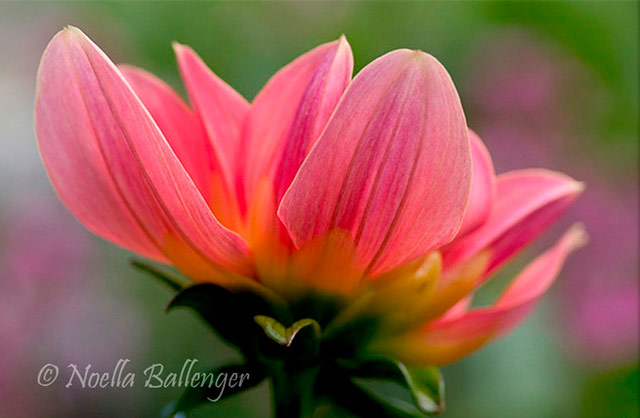
Dahlia
4. Just because you’re working closer, don’t discard all of the good exposure and composition techniques you know. They’ll work up close, too.
5. One shot won’t tell the entire story. Take more than one to show different perspectives and to tell different stories about the subject. Be experimental.
Flowers are easy to feel “intimate” with. You can get close; you can use a variety of senses such as touch and smell to tap into your own feelings about the image. And keep in mind that bringing your feelings about the subject matter into the image will carry over to all subject areas. So get out to a garden or do something to bring the garden inside. Feel the feelings, smell the aromas, enjoy the touch–and then translate all of that into an image that will captivate your viewer.
by Noella Ballenger
© 2015 Noella Ballenger. All rights reserved.

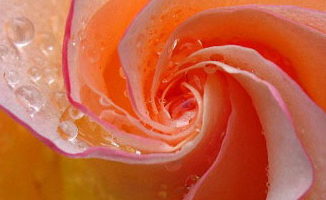
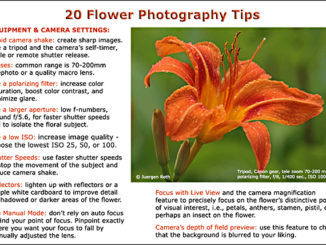
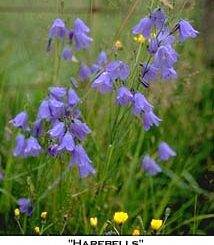
Leave a Reply